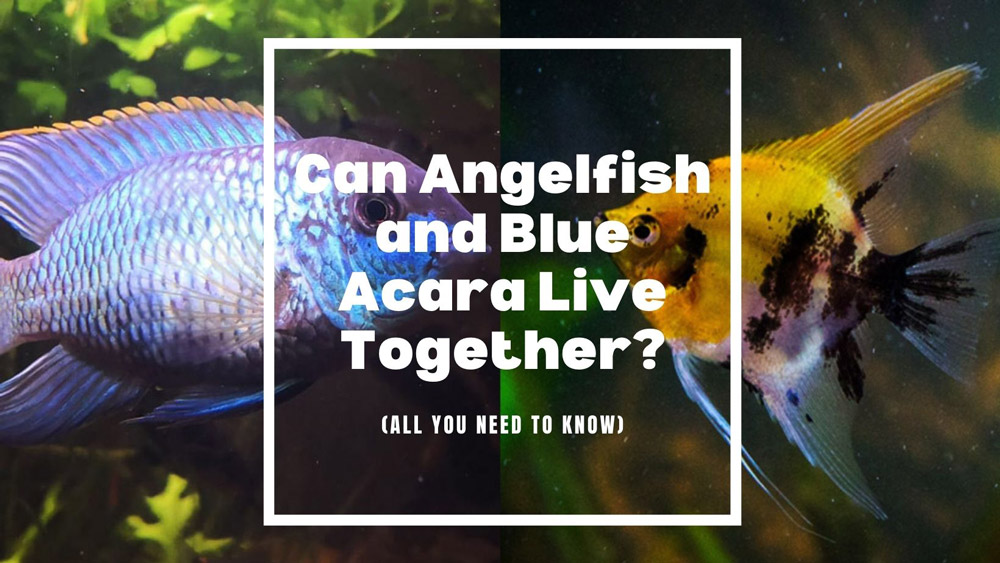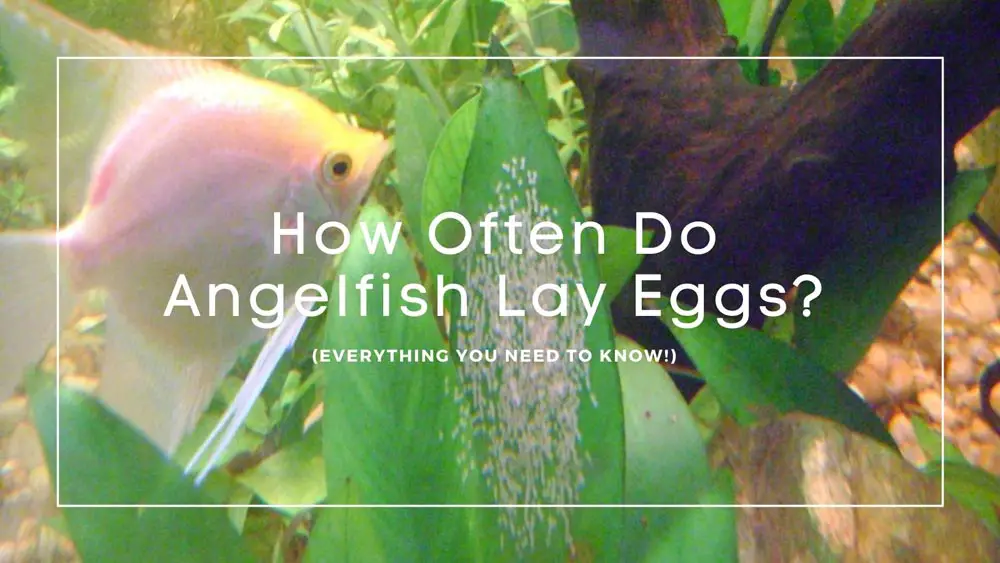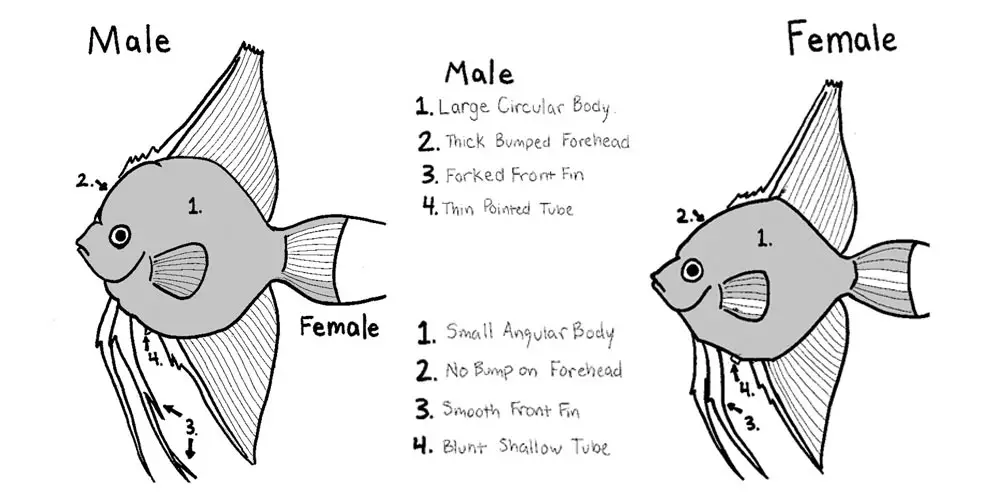The Freshwater Angelfish (Pterophyllum scalare) and the Blue Acara are two absolutely stunning species to look at if you’re someone who is looking for a unique group of fish for a South American cichlids tank.
Both fish are known for their vivid colors and peaceful nature. In addition, they are relatively easy to care for and thrive when kept in schools in a species-only aquarium.
But can you keep Angelfish and Blue Acara together? This article reveals his real-world answers to this most frequently asked question in the aquarist community.
Can Angelfish and Blue Acara Live Together?
If you do not intend to breed both fish, the most common Angelfish (Pterophyllum scalare) and Blue Acara can live together as long as you have a large tank of at least 125 gallons (72″ x 18″ x 21″), since Angelfish need plenty of height to fully extend their fins, and Blue Acaras are generally not known to be fin nippers.
While there are NO guarantees even though we know these combinations do work in most instances, especially when working with Cichlids. IMHO, trial and error is the only way to do this and see how these fish work out together in your aquarium. Having a backup plan is always a good idea, just in case you do run into problems.
No matter what happens, don’t be discouraged. After all, choosing suitable tank mates is always a challenge every aquarist faces.
From my first-hand experience, there are some things that can help determine fish compatibility. In the following sections, we will go through these factors with the Angelfish and Blue Acara as an example.
Species of the Angelfish And Blue Acara
The freshwater Angelfish is one of the most recognized species in the aquarium hobby, scientifically known as Pterophyllum, a small genus of cichlid fish native to the waters in tropical South America.
There are three recognized Angelfish species: P. scalare, P. leopoldi, and P. altum. Most angelfish sold in the trade are P. scalare. Sometime you may obtain a P. altum. But, the smallest and most aggressive species Pterophyllum leopoldi is the hardest to find in the hobby. We will only focus on Angelfish (Pterophyllum scalare) in the following.
The Blue Acara has two variations: the true Blue Acara (Andinoacara pulcher) and the Electric Blue Acara (Andinoacara sp.). The former originates from South and Central America and can reach 7.8 inches (20 cm), while the latter may be a hybrid of true Blue Acara mixed with Blue Rams, remaining a smaller size at 4.8 inches (12cm).
However, these fish tend to share the same environment and have similar care requirements. Therefore, in this article, we will call them Blue Acaras.
Habitats of the Angelfish and Blue Acara
No matter whether you are setting up a single species or community aquarium, it’s best to recreate the fish’s natural habitat as much as possible to provide a stress-free environment.
Below are the details of Angelfish and Electric Blue Acara’s natural habitat, as well as the recommended water conditions:
| Angelfish | Blue Acara | |
|---|---|---|
| Origin | South America | Central and South America |
| Water Temperature | 75° – 86° F (24°C – 30°C) | 64° – 73° F (18°C – 23°C) |
| pH range | 6.0 – 8.0 | 6.5 – 8.0 |
| dH range | 5 – 13 | 6 – 25 |
| Diet | omnivores | omnivores |
| Difficulty | A very hardy and adaptable fish | A relatively peaceful hardy fish |
As you see, Angelfish is an Amazonian species that prefer warm and soft to neutral waters, while Blue Acaras are mainly found in more alkaline, harder waters. Although these two fish are not found in the same natural habits, they can still thrive in the same water conditions.
Like most South American cichlids, they are hardy and adaptable and can accept a wide range of water conditions.
Fish Size and Age
Despite these two fish being generally peaceful, they are opportunistic feeders in the wild and will not hesitate to eat small fish that fits into their mouth. Therefore, always choose Angelfish and Blue Acaras that are roughly the same size as those in your aquarium.
As a result, if you want to keep Angelfish with Blue Acaras, it’s best to purchase juvenile fish and allow them to grow together. This way, they are more likely to get along as juveniles are usually easygoing even when they are not from the same species, or they are known to become aggressive when they reach adulthood.
Behavior & Temperament of Angelfish and Blue Acaras
Angelfish are not considered to be schooling fish, but they do shoal or swim together. You can keep Angelfish singly in a tank, but a group is a good way to go about their well-being.
Since Blue Acaras are curious species, they are not known to be fin nippers like tiger barbs, most tetras, Skunk Botia and Gobies. There is no need to worry that they will nip Angelfish’s fins.
Aquarium Size & Dimension Requirements
| Species | Max Size | Average Size | Tank Size (Min) |
|---|---|---|---|
| Angelfish (P. scalare) | L: 6″(15 cm) H: 8″(20 cm) | L: 6″ (15 cm) H: 8″ (20 cm) | 30 g (36″ x 18″ x 12″) |
| True Blue Acara (A. pulcher) | 8″ (20 cm) | Male: 4.8″ (12 cm) Female: 3.2″ (8 cm) | 30 g (36″ x 18″ x 12″) |
| Electric Blue Acara (A. sp.) | 6″ (15 cm) | 5″ (12.7 cm) | 30 g (36″ x 18″ x 12″) |
Both fish have a very manageable size and can be kept in medium-sized single-species aquariums. However, mixing two fish in a community tank is a totally different story.
Unlike Blue Acaras, the Angels will grow tall rather than long, which means they will fit and work better in the taller tank.
In order to meet their needs and maintain good water quality at the same time, Angelfish and Blue Acaras should be kept in a minimum tank size of at least a 125-gallon aquarium.
Quantity of Angelfish and Blue Acaras
Angelfish and Blue Acaras are not boisterous schooling fish and don’t need to be kept in large groups. A group of four Angelfish will do just fine.
Blue Acaras, on the other hand, make sure the total number of these fish is divisible by two to prevent anyone from potentially getting picked on by Angelfish.
If you plan on keeping multiple fish in the same tank, you’ll need more space. The more room they have, the more comfortable and less aggressive they will be.
Gender
Another consideration is the gender of your fish. Male fish tend to be more aggressive and territorial than female fish, and their territorial behaviors become even more pronounced when attempting to pair off and spawn.
Dominance Hierarchies and Personalities
There is a big misconception that all fish are either peaceful or aggressive; there is a difference between fish’s personality and behavior.
It’s important to remember that not all fish from the same species will behave the same. The truth is that each fish has its own unique personality. Some Angelfish and Blue Acaras are naturally more timid than others, while some are quite outgoing.
When it comes to Angelfish, there is a “social” hierarchy or “pecking order” that determines which fish is the most dominant. The most dominant fish will be the one that gets first dibs on everything from food to the best hiding spots.
The hierarchy can change over time as fish grow and mature. The biggest and most aggressive fish will usually be at the top of the hierarchy, but that doesn’t mean they will always stay there.
As for Blue Acaras, they are not as “social” as Angelfish, but they still have their own hierarchy.
Sometimes, the success of mixing Angelfish and Blue Acaras depends on the dominant fish’s personalities.
Conclusion
That’s everything you need to know about Angelfish and Acara compatibility before making any decisions.
While Angelfish and Blue Acaras can be kept together, there are some things you need to take into consideration, such as fish and tank size, number of fish, gender, etc.
With that being said, if you do your research and are prepared to deal with any potential problems, then go ahead and give it a try. Who knows, you might just end up with a beautiful and unique-looking aquarium.











